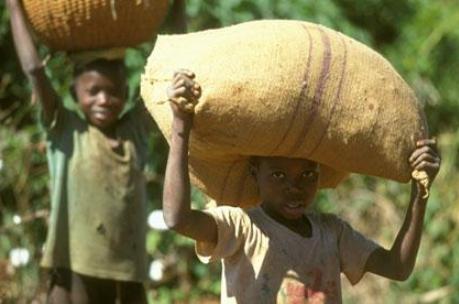Children carrying heavy loads on farm is worrying – Development Expert
 Carrying of heavy loads on the head is the most common child labour occurrence on cocoa farms in Ghana, according to research reports.
Carrying of heavy loads on the head is the most common child labour occurrence on cocoa farms in Ghana, according to research reports.
Mr Prince Gyamfi, the Deputy National Coordinator of International Cocoa Initiative (ICI), told journalists at a training programme that by law, children were not permitted to carry head loads, which were more than 30 per cent of their total body weights, over distances beyond three kilometres.
However, he said, the farmers complain that it was challenging to comply because it was impracticable to daily carry weighing scales to their farms to take the measurements. degeneration.
The ICI is working with the media, state actors and civil societies to ensure that children in cocoa growing communities in the Ashanti, Central, Eastern and Western regions, enjoy their full rights to grow and develop into healthy and productive adults for nation building.
Several medical research has cautioned that carrying heavy loads on the head, over time, could result in the early onset of degeneration of the bones, nerves, muscles, ligaments and tendons in the neck region.
This means that putting too much pressure or compressing the structure of the neck would lead to injuries that would cause pain or dislocation of muscular skeletal in the spine, which could radiate to the arms in the future.
Mr Gyamfi, therefore, urged stakeholders in the fight against child labour to join efforts in addressing this problem, which he said, was also categorised as a hazardous activity, under the Hazardous Child Labour Activity Framework for the Cocoa Sector in Ghana.
He said they were chalking significant success in other areas of their operations. operations.
Child Labour is internationally defined as, “All work that deprive children (persons under 18 years) of their childhood, their potential, their dignity and undermine their physical and physiological development”.
My Gyamfi said under Framework, hazardous activities on cocoa farms, also included the clearing of forests and felling of trees; bush burning; working with and exposure to agro-chemicals; breaking of cocoa pods with breaking knives; working with dangerous tools and motorised farm machinery; and climbing tall trees higher than three metres to cut mistletoe with cutlasses.
“Hazardous work, is work by its nature or the circumstances in which it is carried out, is likely to harm the health, safety, or morals of children,” he explained.
“For example, the risk associated with motorised agricultural machinery could be for someone to become trapped in moving parts…; children are more likely to face work-related accidents because they are less experienced, ignorant of the dangers and risks, and how to prevent them.”
Mr Gyamfi referred to an ILO report of 2004, which states that about 22,000 children worldwide are killed annually through hazardous work.
According to the ILO, with its stakeholders, children, are, however, permitted to engage in work appropriate for their ages- outside school hours, for short periods, under the supervision of their parents and guardians.
This type of work, which should not exceed two hours on school days, and three hours at weekends and on holidays, must be helpful in developing their capacities and skills and to encourage them to learn family responsibilities and to grow into responsible adults.
On the cocoa farms, they are permitted to assist in cooking and serving food, running farm errands, gathering and breaking of cocoa pods with mallets or hitting them on the ground, scooping and removing of the beans, carting minor loads, plucking cocoa pods within hand range and assisting in planting.
At the community level, this is done through baseline surveys, engagements, community action plans, formation of development and management committees and child clubs, mediation roles, training and pro-poor interventions.
The three-day training for the journalists, is therefore to deepen their understanding of their issues to empower them to play effective roles in dealing with the menace in all of child labour in all of its forms.
Source: GNA
